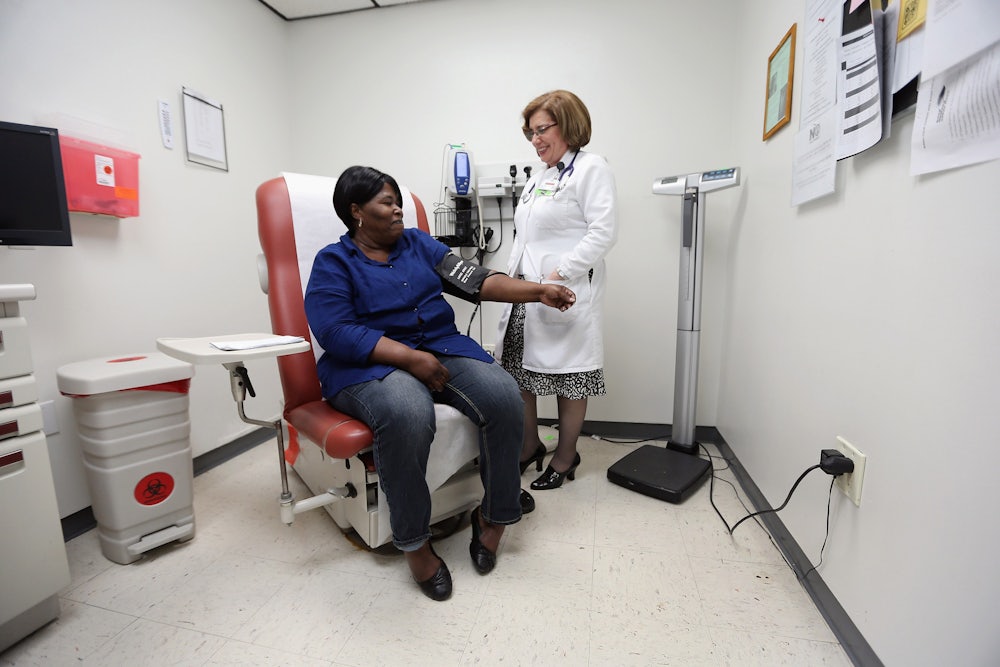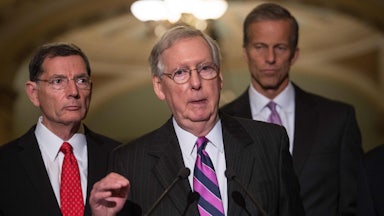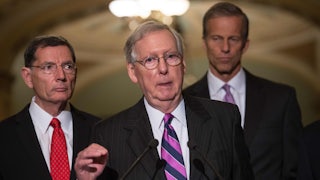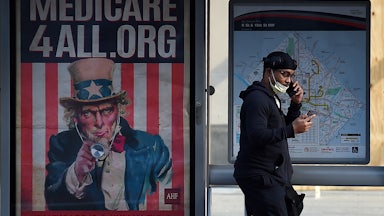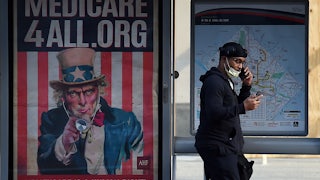With the coronavirus pandemic waning across the United States, a new government report has kicked up a surprising and groundbreaking health statistic: Medicaid enrollment now tops 80 million people. That means nearly one in four Americans rely on the public program for health insurance coverage—eight million more than just a year ago. The uptick was likely driven by a host of factors: the implementation of Medicaid expansion in several new states in 2020, layoffs and employer-sponsored insurance loss rendering people newly eligible, previously eligible people inspired to sign up because of the pandemic, and new rules forbidding states from elbowing patients off the rolls during the public health emergency.
Meanwhile, millions more patients are currently eligible for Medicaid but remain unenrolled; others currently in the so-called coverage gap in nonexpansion states may finally become eligible through legislation like that being introduced by Representative Lloyd Doggett, which would allow municipalities to bypass state governments to expand Medicaid themselves. Taken altogether, the Medicaid program is heartier than ever before—a reality that some observers would argue offers a heartening counterpoint to doom-and-gloom assessments of our nation’s health care system. As one headline in The New York Times put it, “Obamacare, in its first big test as safety net, is holding up so far.”
It’s absolutely true that Medicaid—the expansion of which accounted for the lion’s share of insurance gains under the Affordable Care Act—is a big improvement on nothing. It has saved and improved lives, filtered patients into the health care system who had otherwise been locked out of it, and provided some peace of mind in the place of nagging worries about what could befall their families in the event of a health disaster. But when a means-tested program, initially conceived as a way to uphold the private insurance system by absorbing the patients it marginalized, becomes such a critical aspect of the health care financing system that it covers a full quarter of the American public, it’s worth asking what went awry.
There’s a very obvious answer. What went wrong was the central premise undergirding both the establishment of Medicare and Medicaid and the introduction of the ACA over four decades later: that there’s a virtue in preserving private employer-sponsored insurance, so long as its drawbacks are blunted with smart policies that account for unprofitable patients such as the old, the poor, the disabled, and the already sick. Far from signifying the success of our safety net, skyrocketing Medicaid numbers reflect the increasingly obvious failure of our standard insurance system to justify its own existence—relegating patients to a program far less robust than the universal one they deserve.
As Jamila Michener observes in her book Fragmented Democracy: Medicaid, Federalism and Unequal Politics, the fact that Medicaid is controlled at the state rather than federal level yields intensely unequal outcomes for the patients who rely on it. Some states provide no dental coverage; others cap it at $500 a year. Many states limit how many prescription drugs a patient may take at once, some charge co-pays. Sixteen states don’t cover hearing aids for adults; others constrain eligibility for long-term care.
The experience of being on Medicaid—and what the coverage entitles them to—differs so dramatically across state lines that some of Michener’s interview subjects describe how they are “trapped” in the state where they live. Others describe how they were forced to move to a state that conferred better access to specialized care. Such state-by-state silos can also mean that a Medicaid enrollee is out of luck should they require care while in another state, or if they live near a border and otherwise preferable providers are located across state lines.
Per Michener’s research, Medicaid enrollees are simultaneously relieved to have coverage while also being demoralized by the stigma of what is largely viewed as an anti-poverty program, which is perpetually compounded by the opaque process of contesting decisions about eligibility and what types of care are covered one day to the next. These problems, combined with the perennial popularity of austerity among lawmakers, can erode democracy itself: Michener found that Medicaid enrollment, particularly in states that slash benefits, reduces a patient’s likelihood to register or vote. And as Pamela Herd and Don Moynihan argue in their book Administrative Burden: Policymaking by Other Means, state lawmakers increasingly add new hoops for enrollees to jump through as a budgetary tactic, threatening patients with coverage loss for failing to confirm eligibility several times a year, among other obstacles.
In a highly commodified health care system, Medicaid does far too little to shield its patients from market forces: One study found that Medicaid provider networks are some 63 percent narrower than their commercial counterparts in some places; another found that 30 percent of all providers don’t accept Medicaid patients at all. (And only 36 percent of psychiatrists do.)
But the problem goes well beyond scaled-back choices, gravely affecting care itself: Because poverty has a strong geographical component, large numbers of Medicaid patients are often concentrated in certain areas. And because Medicaid reimbursement rates are so low relative to other payers, and reimbursements for care are hospitals’ dominant source of revenue, providers that serve large numbers of Medicaid patients are underfunded for their troubles. This depletes resources from hospitals that most need them: During the coronavirus pandemic, hospitals that serve mostly poor populations were overwhelmed and had higher mortality rates, while those serving mostly privately insured patients made millions in profits. Disparities in provider revenue also illustrate systemic racism. Nursing homes, which are overwhelmingly funded by Medicaid, remain significantly more segregated than institutions with more balanced sources of revenue.
And yet, Medicaid saves lives. It is a program that performs a function that is sorely needed by broad swaths of the country, many of whom fought desperately to save it when Republicans threatened to overturn the ACA in 2017. But as long as the program remains means-tested and state-controlled, it will stay in more of a defensive crouch than it has to—and its patients will experience the health care system in many worse ways as a result.
